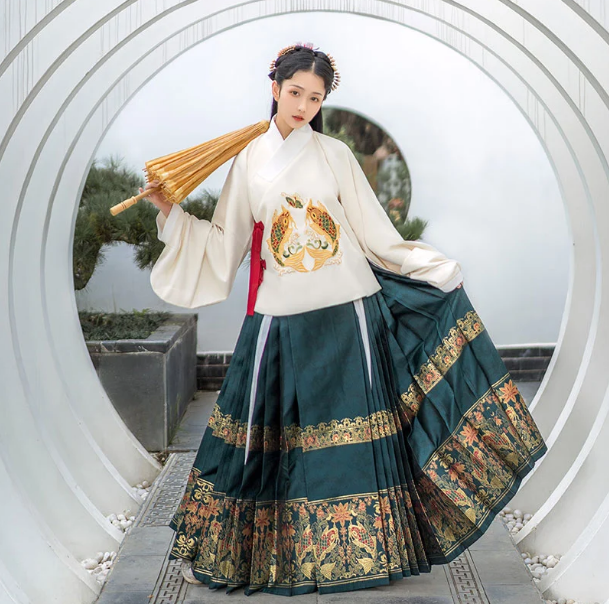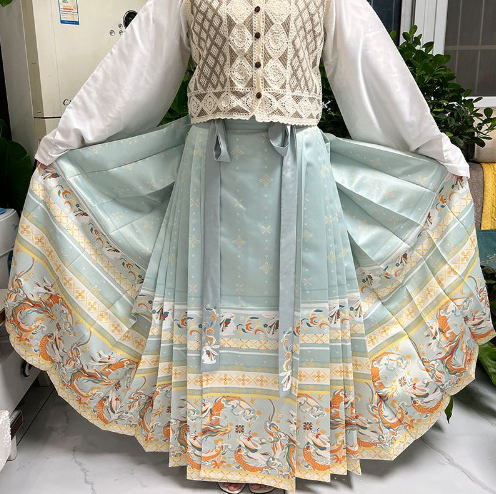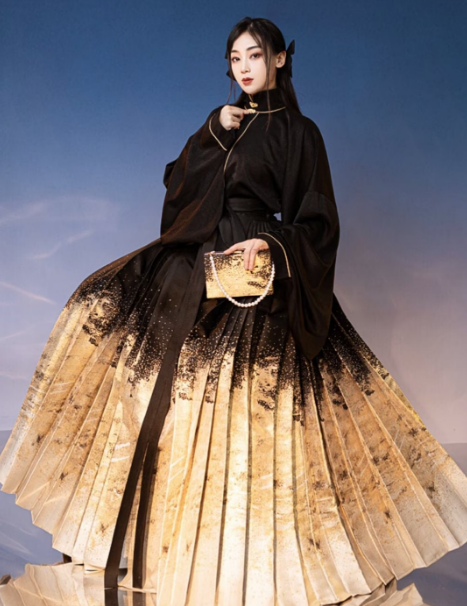Introduction to the Horse Skirt in Historical Context
The horse skirt, a distinctive type of clothing from the Ming (1368-1644) and Qing (1644-1912) dynasties, played a pivotal role in Chinese sartorial history. Its development, style, and usage reflect the socio-cultural dynamics and aesthetic preferences of these periods.
Origins and Early Adoption
The horse skirt, often linked to equestrian culture, emerged primarily due to practical needs. Its design facilitated horseback riding, which was crucial for military, transportation, and leisure activities in ancient China. Over time, the skirt transcended its pragmatic origins to become a fashion statement, admired for both its form and function.

Ming Dynasty – A Period of Flourishing Styles
During the Ming dynasty, the horse skirt evolved significantly in terms of materials, design, and craftsmanship. Tailors often used silk and brocade, materials known for their quality and durability. The cost of these materials, however, meant that elaborate horse skirts were often a symbol of wealth and status. Silk, in particular, was prized for its quality and durability, with higher-grade silk typically reserved for the elite.
Qing Dynasty – Innovations and Diversification
The Qing Dynasty witnessed further innovation in the horse skirt’s design. This era introduced more diverse styles, reflecting the Manchu influence on Han Chinese clothing. This period’s skirts often featured intricate patterns and vibrant colors, displaying advanced dyeing and weaving techniques. The skirts’ specifications, like length and waist size, varied significantly, often tailored to suit the wearer’s preferences and status.
Cultural and Symbolic Significance
The horse skirt was not just a piece of clothing but also a cultural symbol. It embodied values such as bravery, elegance, and social status. In paintings and literature from the Ming and Qing dynasties, the horse skirt frequently appears as a symbol of the wearer’s character and position.
The comprehensive detail regarding the horse skirt’s historical evolution and socio-cultural implications offers a deeper understanding of this unique garment’s role in Chinese history. By examining its origins, materials, cost, quality, and symbolic value, we gain insights into the broader narrative of Chinese cultural and sartorial practices.
Design and Aesthetics of Horse Skirts in the Ming Dynasty
The Ming Dynasty marked a significant era in the evolution of the horse skirt, characterized by exquisite designs, vibrant colors, and intricate craftsmanship. The aesthetic and design principles of the horse skirts during this period reflect not only the fashion trends but also the socio-cultural ethos of the Ming era.
Material Choices and Quality
Silk was the primary material for making horse skirts, revered for its texture, sheen, and strength. Artisans often chose high-quality silk for its durability, an essential factor considering the skirt’s practical use for horse riding. The quality of silk varied, with the finest grades being both a luxury item and a status symbol. Silk’s cost depended on its quality, with the highest-grade silk reaching considerable prices due to its texture, luster, and longevity.
Color and Patterns
Colors played a crucial role in the aesthetics of the Ming horse skirts. Bright colors like red, blue, and green were popular, often complemented by gold or silver threads. These colors did not just add to the visual appeal; they often conveyed certain cultural or symbolic meanings. For example, red symbolized good fortune and joy, while blue represented immortality.
Patterns on these skirts often featured traditional Chinese motifs such as dragons, phoenixes, and floral designs, signifying various virtues and beliefs. Artisans meticulously embroidered these patterns, a task that required immense skill and time, thus adding to the garment’s value.
Cut and Fit
The cut and fit of the horse skirts were tailored to ensure ease of movement while riding. The skirts usually had a flared shape, allowing freedom of movement for the legs. The waist measurements and skirt length varied, often tailored to the individual’s size and preference. The precision in tailoring was crucial to ensure both comfort and style, representing the wearer’s elegance and status.
In summary, the design and aesthetics of horse skirts during the Ming Dynasty showcase an amalgamation of luxury, symbolism, and practicality. The choice of materials, colors, patterns, and the detailed attention to tailoring reflect the rich cultural tapestry of the era. Understanding these aspects offers a deeper appreciation of the artistic and cultural values prevalent in Ming Dynasty China.
Evolution and Variations in the Qing Dynasty
The Qing Dynasty saw significant changes in the design and style of horse skirts, reflecting the era’s diverse cultural influences and evolving fashion trends.
Influence of Manchu Styles
The Manchu rulers introduced new styles and modifications to the traditional Han horse skirts. They preferred straighter cuts and less flared designs compared to the Ming era. This change aimed for practicality and modesty, adhering to the Manchu’s cultural norms and values.
Material and Fabrication
Silk remained a favored material but often combined with other fabrics like cotton or wool, making the skirts more accessible to different social classes. The use of multiple materials allowed for a broader range of prices, making horse skirts available to not only the elite but also the common people. The quality of these fabrics directly influenced the garment’s longevity and appearance.
Changes in Color and Patterns
The color palette became more subdued in the Qing Dynasty, with pastel shades and simpler patterns becoming fashionable. This shift indicated a preference for understated elegance. Traditional motifs like dragons and phoenixes remained popular, but with less ornate executions.
Adaptations for Practical Use
The horse skirts adapted to the changing needs of Qing society. This included adjustments in length and waist size to suit different activities, from formal court ceremonies to everyday wear. The dimensions and specifications of the skirts varied more widely, reflecting a more utilitarian approach to clothing.
The evolution of horse skirts during the Qing Dynasty showcases a dynamic interplay between tradition, cultural identity, and practical needs. The adaptations in materials, designs, and usage patterns reflect the changing socio-political landscape of Qing China, marking a distinct phase in the history of Chinese costume design.
Materials and Fabrication Techniques Used in Horse Skirts
The construction of horse skirts during the Ming and Qing dynasties involved a variety of materials and skilled fabrication techniques, reflecting the era’s textile artistry.

Primary Materials Used
Silk was the predominant material, chosen for its softness, sheen, and strength. High-quality silk ensured durability, a critical factor for active wear like horse riding. Brocade, a richly decorative shuttle-woven fabric, often got used for more ornate skirts, particularly for higher-ranking individuals. Cotton and wool also found use, especially in the later Qing Dynasty, providing cost-effective and practical alternatives to silk.
Fabrication Techniques
Artisans employed various techniques to create horse skirts, each method contributing to the garment’s final look and feel.
Weaving and Dyeing
Weaving techniques were crucial in determining the texture and durability of the fabric. Artisans carefully selected threads and patterns to achieve the desired strength and visual effect. Dyeing was equally important, with natural dyes used to produce a wide range of colors. These dyes often came from plants and minerals, with the color’s vividness and longevity depending on the dyeing technique and the quality of the materials used.
Embroidery and Embellishments
Embroidery played a significant role in enhancing the beauty and value of horse skirts. Skilled embroiderers used silk threads to add intricate designs, like floral patterns, dragons, and phoenixes. These designs not only decorated the skirts but also signified the wearer’s status and taste. Gold and silver threads were sometimes incorporated to add a luxurious touch.
The materials and fabrication techniques used in horse skirts from the Ming and Qing dynasties highlight the period’s sophisticated textile craftsmanship. The combination of quality materials, skilled weaving and dyeing, and elaborate embroidery contributed to the creation of these historical garments, each telling a story of the era’s cultural and artistic heritage.
Cultural and Symbolic Significance in Ming and Qing Societies
Horse skirts in the Ming and Qing dynasties were more than just clothing items; they symbolized status, culture, and beliefs.
Status and Social Hierarchy
The quality, design, and embellishments of a horse skirt often indicated the wearer’s social status. High-ranking officials and nobility wore horse skirts made of finer materials like high-grade silk and brocade, often adorned with intricate embroidery and gold thread. Commoners and lower-ranking individuals had simpler skirts, reflecting their position in society.
Cultural and Ethical Values
The Ming and Qing dynasties emphasized Confucian values, which got reflected in the clothing, including horse skirts. Designs featuring dragons symbolized power and nobility, reflecting the wearer’s authority. Other motifs like phoenixes and flowers denoted virtues like benevolence, righteousness, and integrity.
Symbolism in Colors
Colors on horse skirts carried significant symbolism. Red, associated with good luck and happiness, was commonly used in skirts for festive occasions. Blue and green represented growth, harmony, and fertility. The choice of color in a horse skirt often conveyed a message or expressed a wish, making it an integral part of cultural communication.

Function and Adaptation
The practical aspect of horse skirts also reflected the societies’ evolution. As equestrian activities varied, so did the skirts’ design. This adaptability shows the practical approach of Ming and Qing cultures towards clothing.
The horse skirt’s role in the Ming and Qing dynasties underscores its importance beyond mere functionality. It served as a medium to express social hierarchy, cultural values, and ethical beliefs, representing a rich tapestry of historical Chinese society.
The Horse Skirt’s Influence on Modern Fashion and Heritage Preservation
The historical horse skirt, once a staple in Ming and Qing wardrobes, continues to inspire modern fashion and plays a crucial role in heritage preservation.
Contemporary Fashion Trends
Designers often draw inspiration from the rich colors, intricate patterns, and elegant silhouettes of traditional horse skirts. They adapt these elements to create modern garments that resonate with historical elegance yet fit contemporary style preferences. These adaptations can be seen in high fashion runways and ready-to-wear collections, where elements of traditional Chinese dress fuse with modern aesthetics.
Revival in Modern Apparel
Some fashion lines have directly revived horse skirt-inspired designs, incorporating flowing skirts, layered fabrics, and embroidery reminiscent of the traditional style. This revival not only pays homage to the historical garment but also brings a piece of Chinese heritage into everyday modern wear.
Role in Cultural Heritage
The preservation of horse skirts and their designs plays a vital role in understanding Chinese history and textiles. Museums and cultural institutions exhibit these garments, offering insights into the Ming and Qing dynasties’ social structures, lifestyles, and artistry.
Restoration and Research
Efforts in restoration and research help keep the legacy of horse skirts alive. Textile conservators work meticulously to preserve ancient fabrics, while historians and fashion scholars analyze the designs and construction techniques to gain deeper insights into their cultural significance.
The influence of horse skirts on modern fashion underscores their timeless appeal and the importance of heritage preservation. By continuing to inspire contemporary design and serving as a focal point for historical study, these garments maintain their relevance and continue to enchant generations with their beauty and historical value.